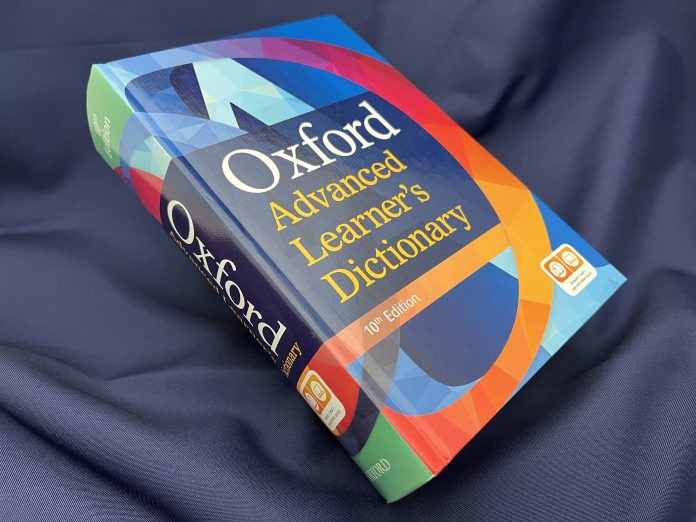In my final article in this series, I will share how to use the Oxford Advanced Learner’s Dictionary to its fullest potential. First, I will introduce some methods for using OALD with intermediate students and learners who are planning to use it in the future. Then, I will explore further ways for advanced users (including teachers) to fully utilize the app’s Full text search function. (For more information about the app, read my previous article.
Part One: Tips for Using OALD with Intermediate Students and Future Users
OALD is an English-English dictionary for advanced learners. For intermediate learners, other resources such as Oxford Wordpower Dictionary are available. But that doesn’t mean intermediate-level learners can’t use OALD. Here is a list of ways to help intermediate students get familiar with OALD, and use it to improve their English skills.
1. Try reading the easy parts!
– Example sentences and columns
English-English dictionaries are challenging. Definitions can be dense, abstract, and confusing1. That said, some parts are relatively approachable. In OALD, examples and columns are written in ordinary English, so they are easy to understand. Key English language learning points, such as usage, synonyms, and cultural information, are covered in the various columns (see the table “Columns” at the end of my second article). Learners should read the sections that interest them.
– Encyclopedic information
While early English-English learner’s dictionaries focused on language-related information, more recent publications include encyclopedic information. OALD also contains quite a few entries about people’s names, place names, and historical events. These are explained concisely, in plain English, and with relevant information, making learning fun and educational:
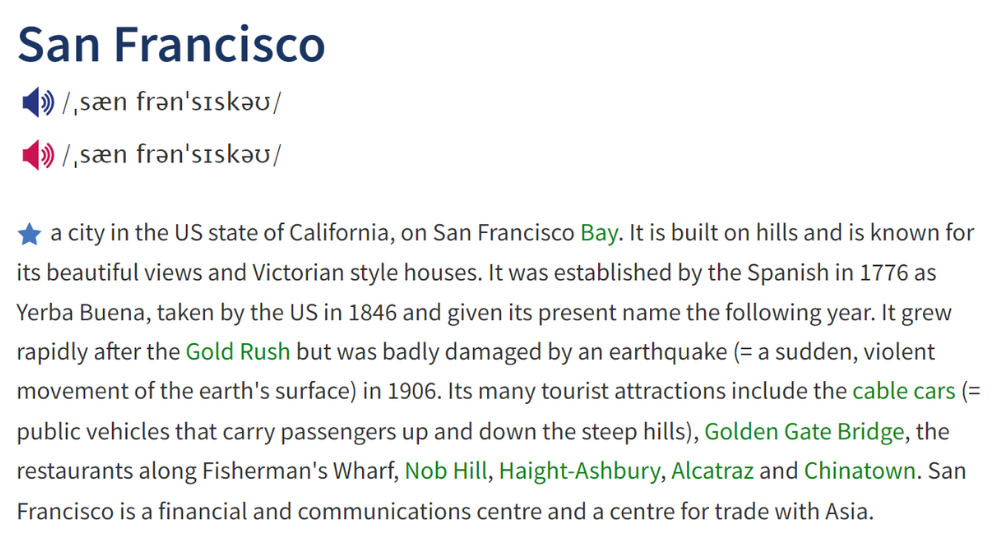
2. Review familiar vocabulary!
– Basic language
As is often pointed out, it’s good to look up words you have already learned in an English-English dictionary. Since you already know the meaning in your first language, it is easier to understand the definition, and it can be an eye-opening experience for learners. In my Guide to the practical usage of English monolingual learners’ dictionaries (p. 9), I suggested looking up the words not bad, climb, international, and willing in order to draw the reader’s attention to the gap between the Japanese translation and the English meaning. Not bad literally translates to warukunai in Japanese, but the English definition reveals that the phrase in fact has a more positive connotation:
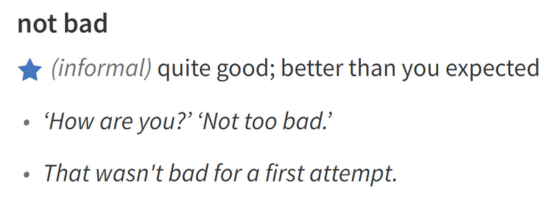
– Loan words found in English
Definitions of words that have entered English from your language should be familiar and easy to read. As far as Japanese is concerned, by entering Japanese as the keyword in the Advanced Search on the CD-ROM accompanying OALD 8, you will find the following Japanese-origin and Japan-related phrases:
aikido, anime, Bon, bonsai, bonze, bullet train, bushido, butoh, futon, geisha, hiragana, ikebana, ju-jitsu, kabuki, kanji, karate, katakana, kendo, kimono, manga, miso, ninja, Noh, obi, origami, pachinko, romaji, sake, sashimi, shiitake, Shinto, Shogun, soy sauce, sumo, sushi, tatami, tea ceremony, tempura, teriyaki, wasabi, yukata, Zen
As of March 2023, the following phrases have been added to the online OALD2:
bento, cosplay (noun, verb), cosplayer, edamame, emoji, hibachi, kanban, matcha, mecha, ramen, TabataTM, Wagyu, yuzu
3. Check the items in bold!
– Usage patterns
In addition to headwords, OALD also employs boldface. Usage patterns, and prepositions and adverbs used with the headword are highlighted in bold. This makes it possible to check aspects of usage which even advanced students need to pay special attention to, such as whether or not a noun can be followed by an appositive that-clause:

– Set phrases
Set phrases and important collocations used in example sentences are also shown in bold. Where the meaning is not clear, a note in brackets is provided:

It is important to learn these words and phrases in bold, as they are useful for both productive and receptive language skills.
4. Look up anything using Full text search!
I will cover the app’s Full text search function more comprehensively in the next part, but it’s worthwhile mentioning here that intermediate users can also use it to search for whatever word or phrase that interests them. For example, if you search for World Cup, you’ll find fascinating examples scattered throughout OALD that are both memorable and handy for conversation:
- They crashed out of the World Cup after a 2–1 defeat to Brazil. (s.v. crash out)
- The team are ready for next week’s World Cup clash with Italy. (cup 4, Extra Examples)
- The victory keeps San Marino’s dream of a World Cup place alive. (dream 2, Extra Examples)
- They were disappointed by the team’s early exit from the World Cup. (s.v. exit 4)
- World Cup fever has gripped the country. (fever 4)
- He’s been chosen to represent Scotland in next year’s World Cup Finals. (s.v. represent 3)
Part Two: Full text search for Advanced Learners
In my previous article, I introduced the Full text search function available on the OALD app as follows:
Full text search allows you to search for headwords, idioms, and example sentences based on single or multiple key words. Notes attached to example sentences, extra examples, and other columns are also searchable. This function also picks up words and phrases which are not headwords, idioms, and other subheadings, making searching on the app more comprehensive, more flexible, and complementary than the online version, which doesn’t allow such searches.
A large proportion of advanced users must be language teachers. Many teachers, myself included, use OALD not only for their own searches, but also for class preparation. I am very indebted to Full text search. Although it is not limited to teachers, we will look at additional ways to use Full text search in the second half of this article.
1. Comprehensive search: Check whether the word is included or not
I have been teaching English at university for more than a quarter of a century. I have used English-English dictionaries to prepare for classes, and have created and distributed materials based on the English-English dictionary for about a third of those classes. I haven’t always prepared perfectly. In fact, twice I’ve had a student point out that I overlooked a phrase, and that the phrase is listed there in the dictionary. Had Full text search been available, I could have double checked and avoided that embarrassing mistake.
Full text search can be used to find out whether a word or phrase is included in OALD as a headword, idiom, or example sentence. For example, you can instantly see that in plain view, which is not entered as a phrase, is included in Extra Examples under sense 2 of view (The knife was in plain view on the kitchen table.). The saying Fine feathers make fine birds is not listed at all. The phrase like it or not is not listed as such, but Full text search shows us that it is included in an example sentence under sense 2 of whether (I’m going whether you like it or not).
2. Pinpoint searches for definitions
Some words have different meanings depending on use and context. For example, what is the meaning of fill in the sentence below?
It [The milk froth] should be nice and airy, yet firm at the same time, which is not an easy order to fill.
(Morita, Akira. 2014. Teacher’s Manual for BBC World Profile on DVD. Nanundo. 94.)
Even with Shortcuts (subheadings which show the general meanings of a headword), searching polysemous words can be onerous even for advanced users. With that in mind, a Full text search using the keywords fill and order yields the following hits:
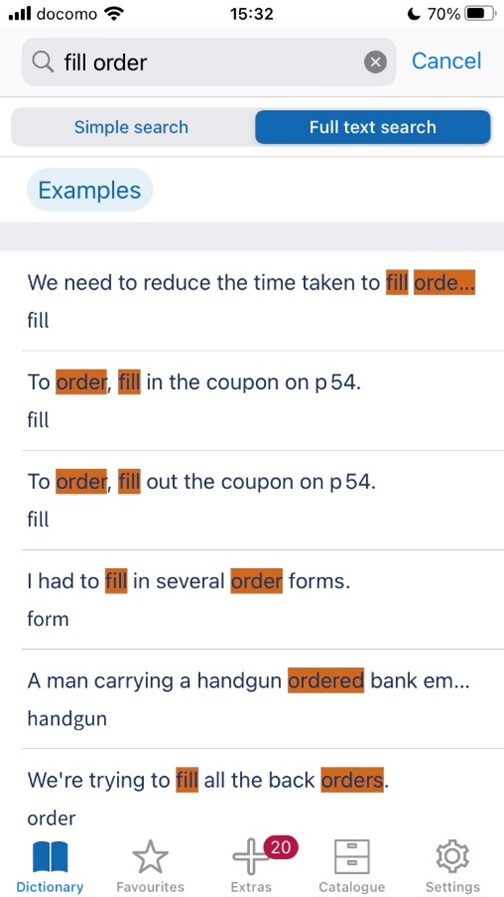
If you tap on the first example, which appears to be the most relevant, you can see that it corresponds to sense 12 of fill:

3. Improve your vocabulary with Full text search
Advanced users can also use Full text search to improve their English knowledge. Learners can search for the words and phrases they are interested in, and examine the example sentences to see how they are used, paying attention to meaning, nuance, collocation, and context. For example, if you look up end up, you will find that the phrasal verb has the following usage patterns:
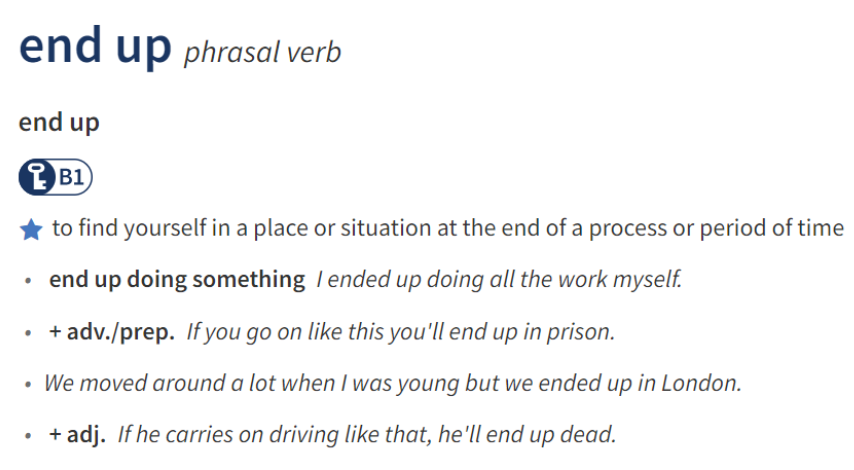
By conducting a Full text search for example sentences rather than just for headwords, you will find a greater variety of results from all dictionary texts:
?In end up doing something, not is placed before the ing form of the verb:
- For all their talk of equality, the boys ended up not doing any cooking. (s.v. talk noun 4, Extra Examples)
?End up can be followed by these adverbial and prepositional phrases:
- We got lost and ended up miles away from our intended destination. (destination, Extra Examples; intended 1)
- I usually end up with gravy down my shirt front. (front 1, Extra Examples; shirt front)
?When end up is followed by a noun, as is often added:
- Without education, these children will end up as factory fodder (= only able to work in a factory). (fodder 2)
- ‘Maybe you’ll end up as a lawyer, like me.’ ‘God forbid!’ (God/Heaven forbid (that…))
- I started as a trainee and ended up a supervisor. (start verb 6, Extra Examples)
?End up can be used with the following set phrases:
- The scene with the elephant ended up on the cutting room floor (= was not included in the final version of the film). (s.v. cutting room)
- The firm ended up deep in debt. (deep 14)
- His attempts to arrange a party ended up as a comedy of errors (= he made so many mistakes it was funny). (s.v. error)
- The economy went into recession and taxpayers ended up footing the bill. Sound familiar (= does that sound familiar)? (s.v. sound verb 1)
OALD’s example sentences are not a corpus. However, they are a carefully screened collection of high-quality examples which illustrate the meaning of headwords. By scrolling or tapping, you can immediately check the definition of the word in the example sentence. You can also check the importance of words based on CEFR (Common European Frame of Reference) and OPAL (Oxford Phrasal Academic LexiconTM), amongst others. (For more information read my first article.) Idioms in example sentences are shown in bold and are often accompanied by notes. The ability to quickly look up meaning, grammar, and pronunciation all in one place is utterly invaluable.
In this series of four articles, I have written about the past and present of OALD, the differences between paper and digital versions, the functions of different media, the impact of digitization on information presentation and search, and hints for effective use. These are just some of the things I’ve been thinking about while researching English-English dictionaries for foreign learners and actually using OALD in my own learning and teaching. I hope that my blogs will help you become familiar with this wonderful resource, and that through the ideas I have introduced you will be able to use it even more effectively.
Notes?
1 With the introduction of defining vocabularies of about 3000 basic words (the Oxford 3000TM in the case of OALD) and full-sentence definitions, definitions in contemporary learner’s dictionaries have become much easier to understand (please see my first article). There is a useful video within the premium online resources called “Understanding dictionary definitions” which explains that the words below are frequently used in definitions and are useful not only for understanding definitions but also for describing things when you don’t know the exact word in English:
process, substance, instrument, act, organization, state, quality
2 In August 2022 many words of Korean origin, such as bibimbap, were added to OALD.
?https://www.oxfordlearnersdictionaries.com/wordlist/new_words??
3 As the topic is Latte Macchiato, order here has a double meaning: ‘requirement’ and ‘request’.
Reference:
Yamada, Shigeru. 2014. Guide to the practical usage of English monolingual learners’ dictionaries: E-ffective ways of teaching dictionary use in the English class. Oxford University Press.
https://www.oupjapan.co.jp/sites/default/files/contents/catalogue/oald/media/oup_guide_to_dictionary_use_2014_e.pdf
Shigeru Yamada is a Professor at Waseda University, Tokyo. He is on the editorial advisory board of Dictionaries: Journal of the Dictionary Society of North America. He was a Co-Editor-in-Chief of Lexicography: Journal of ASIALEX. His specialization is EFL and bilingual lexicography. His recent publications include “Monolingual Learners’ Dictionaries – Past and Future” (The Bloomsbury Handbook of Lexicography, 2nd ed., Ch. 11, 2022).

